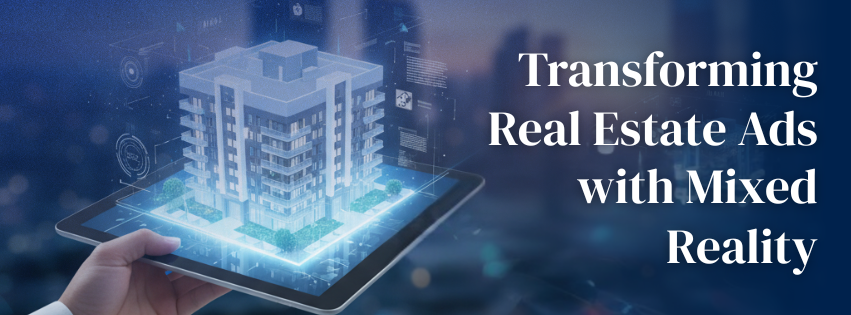
Turning Real Estate Brochures and Billboards into Interactive Experiences with Mixed Reality

Published Date
The real estate industry has always relied on visuals — from glossy brochures to giant outdoor billboards — to capture a buyer’s imagination. But in today’s digital-first world, static images and traditional ads are no longer enough to truly engage customers. Buyers now want experiences, not just information. That’s where Mixed Reality (MR) comes in — blending the real and virtual worlds to create immersive, interactive experiences that leave a lasting impression.
What is Mixed Reality?
Mixed Reality combines the best of Augmented Reality (AR) and Virtual Reality (VR) to create an experience where digital elements interact with the real world.
- With AR, users can see digital visuals layered over their physical surroundings (for example, scanning a brochure to view a 3D model of a building).
- With VR, users step into a completely virtual environment, such as taking a virtual tour of an apartment.
Mixed Reality brings these together — allowing potential buyers to experience properties as if they were physically present, even before a single brick is laid.
1. Turning Physical Brochures into Interactive Experiences
Imagine picking up a real estate brochure at a property expo. Instead of just flipping through photos, you scan it with your phone — and suddenly, the building comes to life in 3D right in front of you. You can rotate it, zoom in, explore floor plans, and see interiors with furniture and lighting.
This is one of the most powerful uses of Mixed Reality in real estate. By bridging the gap between print and digital, MR turns traditional marketing materials into interactive storytelling tools. Customers don’t just see your property — they experience it.
This leads to higher engagement and a stronger emotional connection with the brand. It also helps buyers visualize spaces better, reducing confusion or uncertainty during decision-making.
2. Bringing Billboards and Outdoor Ads to Life
Outdoor advertising, especially OOH (Out-of-Home) campaigns, has always been key for real estate marketing. But static billboards often struggle to stand out in a sea of visual noise. With Mixed Reality, that changes completely.
Now, a passerby can scan a billboard with their smartphone and instantly see a dynamic 3D version of the building, the surrounding area, and even watch short walkthrough videos in AR view.
For example:
- A giant billboard of a luxury apartment could transform into a virtual model showing the lobby, swimming pool, and skyline view.
- A QR code placed strategically on the ad could open an AR-based apartment tour or show price updates and availability in real time.
These immersive experiences create a “wow” factor, turning ordinary ads into memorable interactions that drive higher recall value and better brand recognition.
3. Virtual Site Visits: Explore Properties without Being There
Mixed Reality allows potential buyers to “visit” a property without physically being on-site. By wearing a headset or using a smartphone, users can walk through the property virtually — explore every room, view interior design options, or even switch between day and night lighting effects.
This is especially valuable for:
- International buyers who can’t visit the property in person.
- Pre-construction projects, where physical models don’t yet exist.
- Developers and brokers, who can present multiple properties quickly and effectively.
Virtual site visits save time, reduce travel costs, and make the buying process much faster and more convenient.
4. Increasing Customer Recall and Emotional Connection
Traditional advertising often fades from memory after a few seconds. But when users engage with an MR experience — scan a brochure, interact with a 3D model, or virtually walk through an apartment — they’re actively involved. This active participation creates stronger memory retention.
Studies show that interactive visuals boost recall rate by up to 75% compared to static content. That means potential buyers are more likely to remember your project name, your brand, and the experience you offered — long after the interaction.
5. Benefits for Real Estate Companies
For developers, brokers, and marketers, Mixed Reality offers several practical advantages:
- Faster Sales Cycles: Clients can make quicker decisions after immersive walkthroughs.
- Reduced Cost of Physical Models: MR eliminates the need for large, expensive miniature setups.
- Improved Communication: Buyers can clearly visualize what they’ll get, reducing post-sale misunderstandings.
- Brand Differentiation: Using cutting-edge MR technology sets your brand apart from competitors still using traditional marketing.
In short, MR isn’t just a marketing tool — it’s a sales accelerator that builds trust and transparency with customers.
6. The Future of Real Estate Marketing
As smartphones and AR glasses become more advanced, Mixed Reality will soon become a standard tool in real estate marketing. From interactive print ads and virtual tours to AR-based property showcases at exhibitions, the possibilities are endless.
Imagine a future where customers simply scan a street billboard and instantly see available flats nearby, compare prices, or even schedule a site visit — all within a single immersive experience.
Mixed Reality bridges imagination and reality, giving buyers’ confidence in their choices while helping brands tell their story more vividly.
Conclusion
Mixed Reality is redefining how people explore, understand, and connect with real estate. It turns ordinary brochures, hoardings, and presentations into memorable experiences that engage all senses and emotions.
In an industry where first impressions matter most, MR helps real estate brands stand out, deliver value, and stay ahead of the curve. The future of real estate marketing isn’t just about what you show — it’s about how you make people feel when they see it.